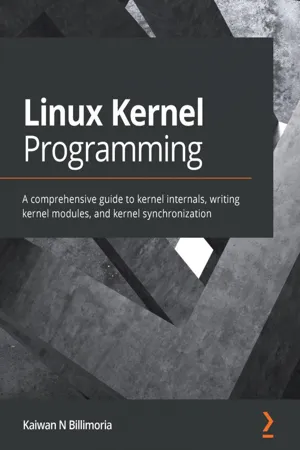
- 754 pages
- English
- ePUB (mobile friendly)
- Available on iOS & Android
Linux Kernel Programming
About this book
Learn how to write high-quality kernel module code, solve common Linux kernel programming issues, and understand the fundamentals of Linux kernel internals
Key Features
- Discover how to write kernel code using the Loadable Kernel Module framework
- Explore industry-grade techniques to perform efficient memory allocation and data synchronization within the kernel
- Understand the essentials of key internals topics such as kernel architecture, memory management, CPU scheduling, and kernel synchronization
Book Description
Linux Kernel Programming is a comprehensive introduction for those new to Linux kernel and module development. This easy-to-follow guide will have you up and running with writing kernel code in next-to-no time. This book uses the latest 5.4 Long-Term Support (LTS) Linux kernel, which will be maintained from November 2019 through to December 2025. By working with the 5.4 LTS kernel throughout the book, you can be confident that your knowledge will continue to be valid for years to come.You'll start the journey by learning how to build the kernel from the source. Next, you'll write your first kernel module using the powerful Loadable Kernel Module (LKM) framework. The following chapters will cover key kernel internals topics including Linux kernel architecture, memory management, and CPU scheduling. During the course of this book, you'll delve into the fairly complex topic of concurrency within the kernel, understand the issues it can cause, and learn how they can be addressed with various locking technologies (mutexes, spinlocks, atomic, and refcount operators). You'll also benefit from more advanced material on cache effects, a primer on lock-free techniques within the kernel, deadlock avoidance (with lockdep), and kernel lock debugging techniques.By the end of this kernel book, you'll have a detailed understanding of the fundamentals of writing Linux kernel module code for real-world projects and products.
What you will learn
- Write high-quality modular kernel code (LKM framework) for 5.x kernels
- Configure and build a kernel from source
- Explore the Linux kernel architecture
- Get to grips with key internals regarding memory management within the kernel
- Understand and work with various dynamic kernel memory alloc/dealloc APIs
- Discover key internals aspects regarding CPU scheduling within the kernel
- Gain an understanding of kernel concurrency issues
- Find out how to work with key kernel synchronization primitives
Who this book is for
This book is for Linux programmers beginning to find their way with Linux kernel development. If you're a Linux kernel and driver developer looking to overcome frequent and common kernel development issues, or understand kernel intervals, you'll find plenty of useful information.You'll need a solid foundation of Linux CLI and C programming before you can jump in.
]]>
Frequently asked questions
- Essential is ideal for learners and professionals who enjoy exploring a wide range of subjects. Access the Essential Library with 800,000+ trusted titles and best-sellers across business, personal growth, and the humanities. Includes unlimited reading time and Standard Read Aloud voice.
- Complete: Perfect for advanced learners and researchers needing full, unrestricted access. Unlock 1.4M+ books across hundreds of subjects, including academic and specialized titles. The Complete Plan also includes advanced features like Premium Read Aloud and Research Assistant.
Please note we cannot support devices running on iOS 13 and Android 7 or earlier. Learn more about using the app.
Information
- Chapter 1, Kernel Workspace Setup
- Chapter 2, Building the 5.x Linux Kernel from Source, Part 1
- Chapter 3, Building the 5.x Linux Kernel from Source, Part 2
- Chapter 4, Writing Your First Kernel Module – LKMs Part 1
- Chapter 5, Writing Your First Kernel Module – LKMs Part 2
- Running Linux as a guest VM
- Setting up the software – distribution and packages
- A few additional useful projects
Technical requirements
- A 2 GHz dual core processor or better.
- RAM:
- Running on physical host: 2 GB or more system memory (more will certainly help).
- Running as a guest VM: The host system should have at least 4 GB RAM (the more the better and the smoother the experience).
- 25 GB of free hard drive space (I suggest more, at least double this).
- Either a DVD drive or a USB port for the installer media (not required when setting up Ubuntu as a guest VM).
- Internet access is definitely helpful and required at times.
git clone https://github.com/PacktPublishing/Linux-Kernel-Programming.git
Running Linux as a guest VM
Installing a 64-bit Linux guest
Table of contents
- Title Page
- Copyright and Credits
- Dedication
- Contributors
- Preface
- Section 1: The Basics
- Kernel Workspace Setup
- Building the 5.x Linux Kernel from Source - Part 1
- Building the 5.x Linux Kernel from Source - Part 2
- Writing Your First Kernel Module - LKMs Part 1
- Writing Your First Kernel Module - LKMs Part 2
- Section 2: Understanding and Working with the Kernel
- Kernel Internals Essentials - Processes and Threads
- Memory Management Internals - Essentials
- Kernel Memory Allocation for Module Authors - Part 1
- Kernel Memory Allocation for Module Authors - Part 2
- The CPU Scheduler - Part 1
- The CPU Scheduler - Part 2
- Section 3: Delving Deeper
- Kernel Synchronization - Part 1
- Kernel Synchronization - Part 2
- About Packt
- Other Books You May Enjoy